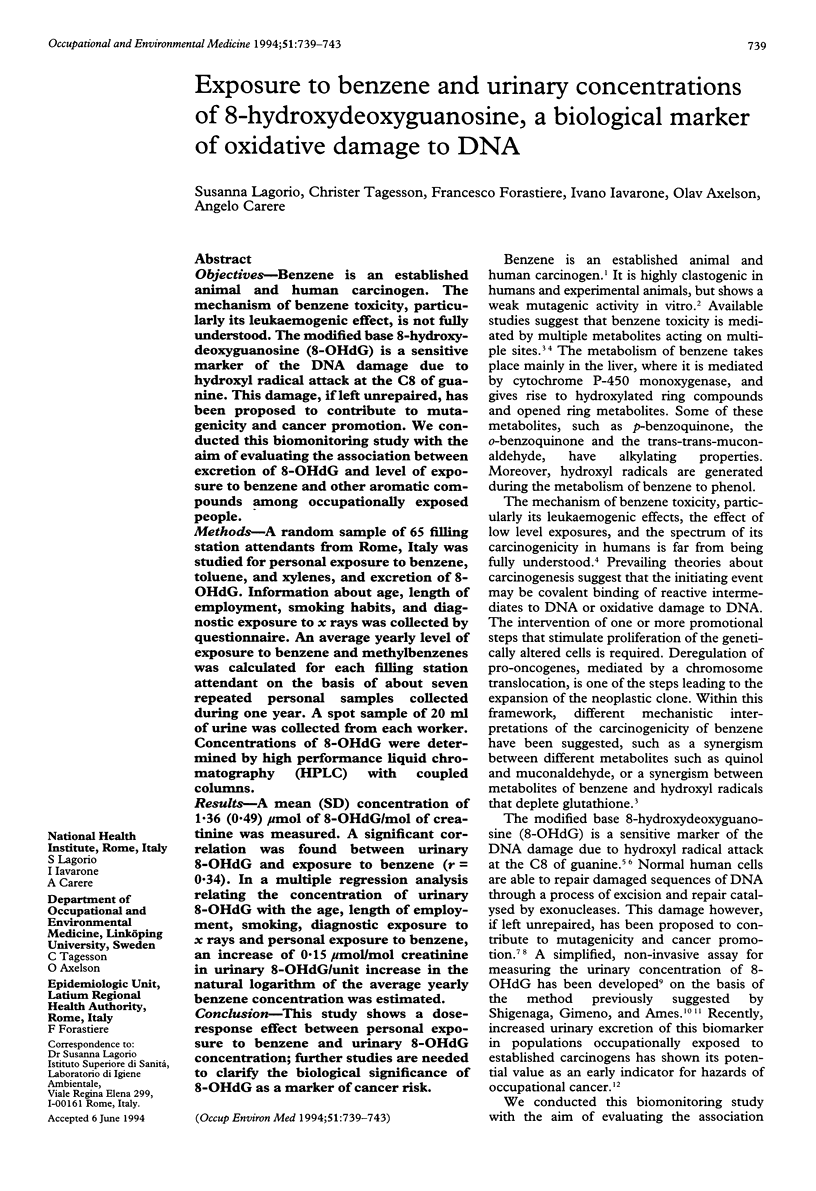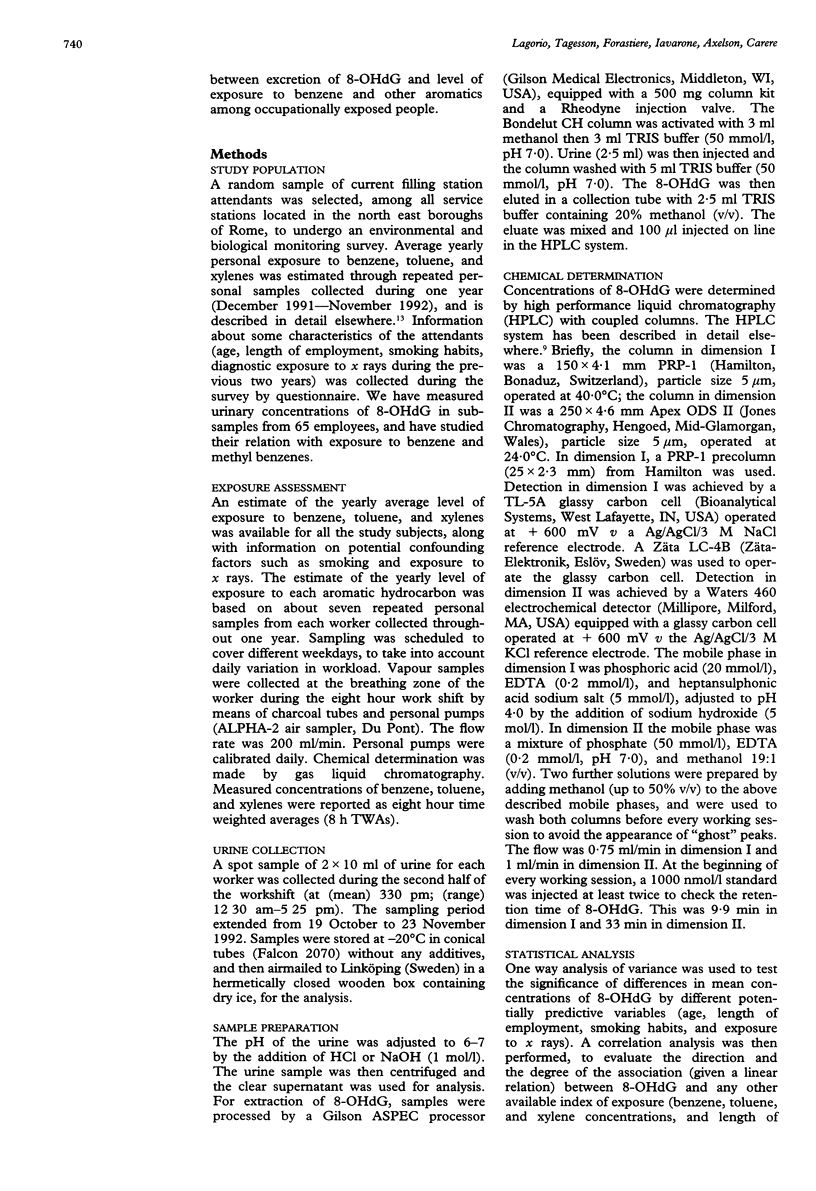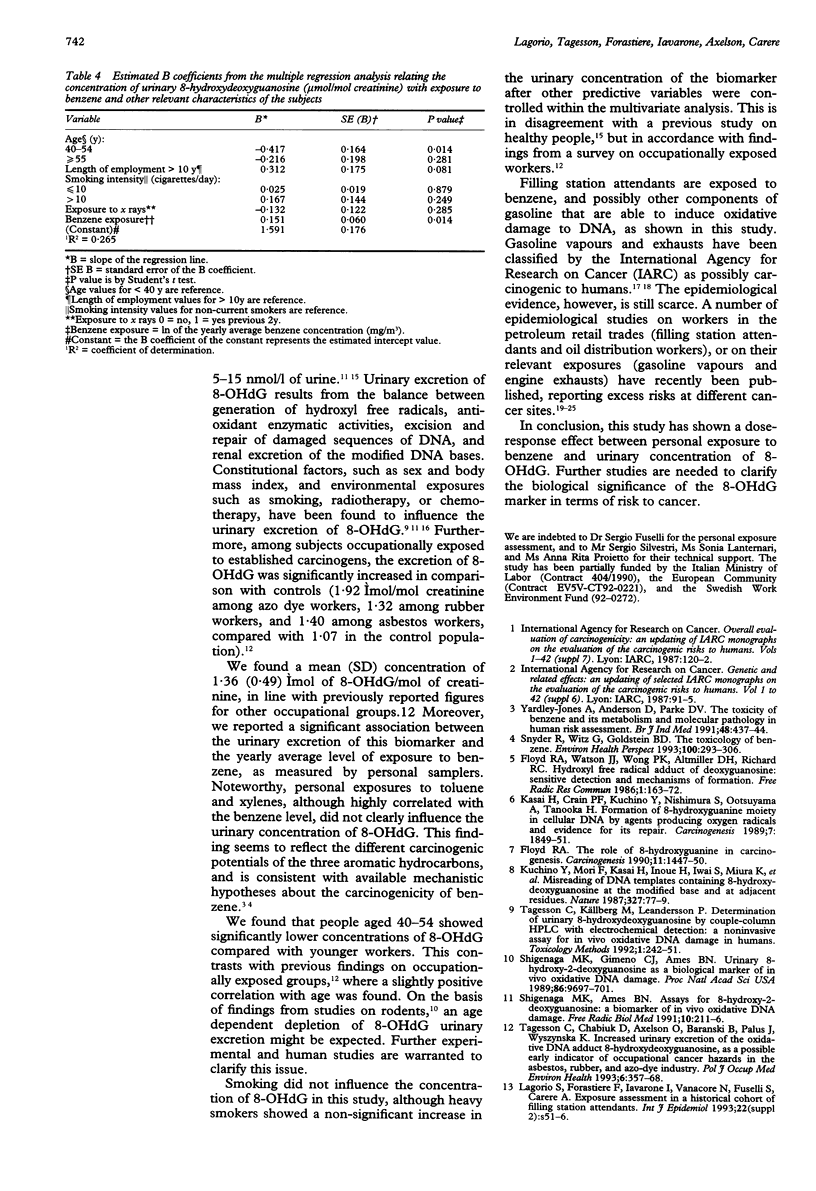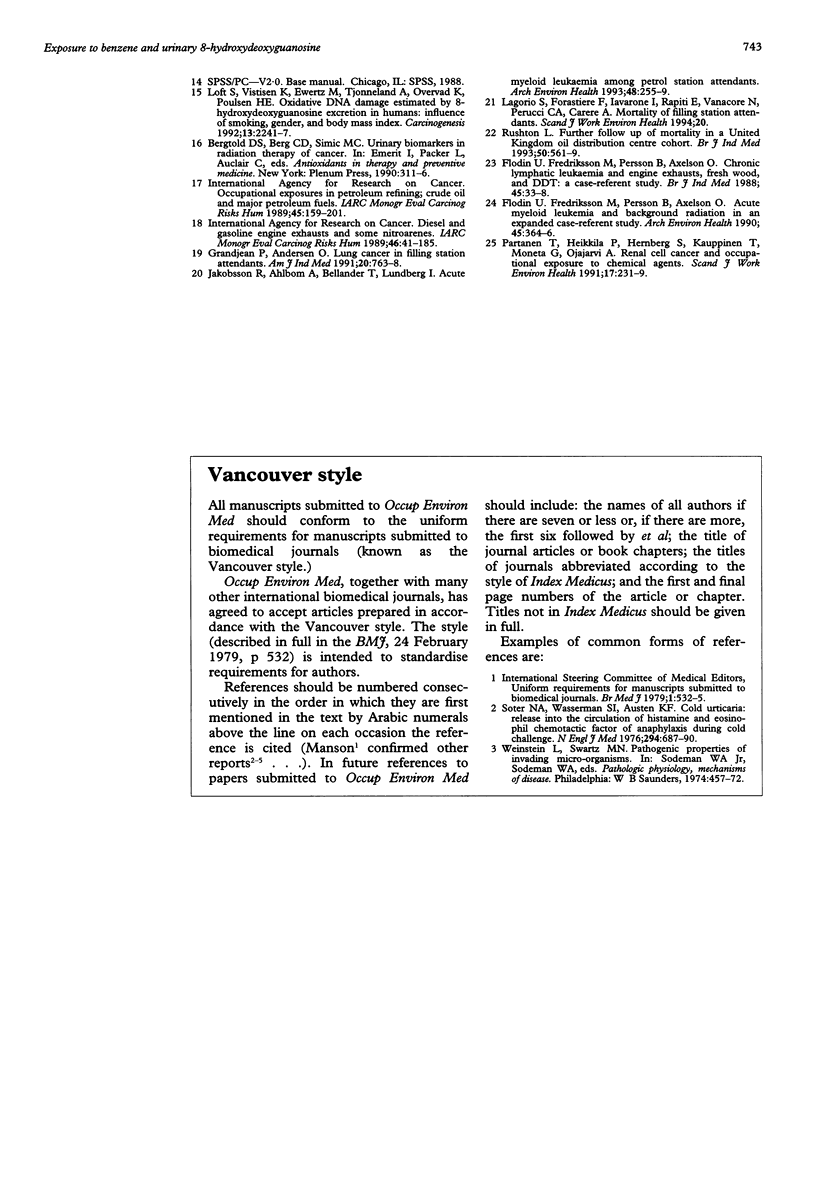Abstract
OBJECTIVES--Benzene is an established animal and human carcinogen. The mechanism of benzene toxicity, particularly its leukaemogenic effect, is not fully understood. The modified base 8-hydroxy-deoxyguanosine (8-OHdG) is a sensitive marker of the DNA damage due to hydroxyl radical attack at the C8 of guanine. This damage, if left unrepaired, has been proposed to contribute to mutagenicity and cancer promotion. We conducted this biomonitoring study with the aim of evaluating the association between excretion of 8-OHdG and level of exposure to benzene and other aromatic compounds among occupationally exposed people. METHODS--A random sample of 65 filling station attendants from Rome, Italy was studied for personal exposure to benzene, toluene, and xylenes, and excretion of 8-OHdG. Information about age, length of employment, smoking habits, and diagnostic exposure to x rays was collected by questionnaire. An average yearly level of exposure to benzene and methylbenzenes was calculated for each filling station attendant on the basis of about seven repeated personal samples collected during one year. A spot sample of 20 ml of urine was collected from each worker. Concentrations of 8-OHdG were determined by high performance liquid chromatography (HPLC) with coupled columns. RESULTS--A mean (SD) concentration of 1.36 (0.49) mumol of 8-OHdG/mol of creatinine was measured. A significant correlation was found between urinary 8-OHdG and exposure to benzene (r = 0.34). In a multiple regression analysis relating the concentration of urinary 8-OHdG with the age, length of employment, smoking, diagnostic exposure to x rays and personal exposure to benzene, an increase of 0.15 mumol/mol creatinine in urinary 8-OHdG/unit increase in the natural logarithm of the average yearly benzene concentration was estimated. CONCLUSION--This study shows a dose-response effect between personal exposure to benzene and urinary 8-OHdG concentration; further studies are needed to clarify the biological significance of 8-OHdG as a marker of cancer risk.
Full text
PDF




Selected References
These references are in PubMed. This may not be the complete list of references from this article.
- Bergtold D. S., Berg C. D., Simic M. G. Urinary biomarkers in radiation therapy of cancer. Adv Exp Med Biol. 1990;264:311–316. doi: 10.1007/978-1-4684-5730-8_49. [DOI] [PubMed] [Google Scholar]
- Flodin U., Fredriksson M., Persson B., Axelson O. Acute myeloid leukemia and background radiation in an expanded case-referent study. Arch Environ Health. 1990 Nov-Dec;45(6):364–366. doi: 10.1080/00039896.1990.10118756. [DOI] [PubMed] [Google Scholar]
- Flodin U., Fredriksson M., Persson B., Axelson O. Chronic lymphatic leukaemia and engine exhausts, fresh wood, and DDT: a case-referent study. Br J Ind Med. 1988 Jan;45(1):33–38. doi: 10.1136/oem.45.1.33. [DOI] [PMC free article] [PubMed] [Google Scholar]
- Floyd R. A. The role of 8-hydroxyguanine in carcinogenesis. Carcinogenesis. 1990 Sep;11(9):1447–1450. doi: 10.1093/carcin/11.9.1447. [DOI] [PubMed] [Google Scholar]
- Floyd R. A., Watson J. J., Wong P. K., Altmiller D. H., Rickard R. C. Hydroxyl free radical adduct of deoxyguanosine: sensitive detection and mechanisms of formation. Free Radic Res Commun. 1986;1(3):163–172. doi: 10.3109/10715768609083148. [DOI] [PubMed] [Google Scholar]
- Grandjean P., Andersen O. Lung cancer in filling station attendants. Am J Ind Med. 1991;20(6):763–768. doi: 10.1002/ajim.4700200607. [DOI] [PubMed] [Google Scholar]
- Jakobsson R., Ahlbom A., Bellander T., Lundberg I. Acute myeloid leukemia among petrol station attendants. Arch Environ Health. 1993 Jul-Aug;48(4):255–259. doi: 10.1080/00039896.1993.9940369. [DOI] [PubMed] [Google Scholar]
- Kasai H., Crain P. F., Kuchino Y., Nishimura S., Ootsuyama A., Tanooka H. Formation of 8-hydroxyguanine moiety in cellular DNA by agents producing oxygen radicals and evidence for its repair. Carcinogenesis. 1986 Nov;7(11):1849–1851. doi: 10.1093/carcin/7.11.1849. [DOI] [PubMed] [Google Scholar]
- Kuchino Y., Mori F., Kasai H., Inoue H., Iwai S., Miura K., Ohtsuka E., Nishimura S. Misreading of DNA templates containing 8-hydroxydeoxyguanosine at the modified base and at adjacent residues. Nature. 1987 May 7;327(6117):77–79. doi: 10.1038/327077a0. [DOI] [PubMed] [Google Scholar]
- Lagorio S., Forastiere F., Iavarone I., Vanacore N., Fuselli S., Carere A. Exposure assessment in a historical cohort of filling station attendants. Int J Epidemiol. 1993;22 (Suppl 2):S51–S56. doi: 10.1093/ije/22.supplement_2.s51. [DOI] [PubMed] [Google Scholar]
- Loft S., Vistisen K., Ewertz M., Tjønneland A., Overvad K., Poulsen H. E. Oxidative DNA damage estimated by 8-hydroxydeoxyguanosine excretion in humans: influence of smoking, gender and body mass index. Carcinogenesis. 1992 Dec;13(12):2241–2247. doi: 10.1093/carcin/13.12.2241. [DOI] [PubMed] [Google Scholar]
- Partanen T., Heikkilä P., Hernberg S., Kauppinen T., Moneta G., Ojajärvi A. Renal cell cancer and occupational exposure to chemical agents. Scand J Work Environ Health. 1991 Aug;17(4):231–239. doi: 10.5271/sjweh.1708. [DOI] [PubMed] [Google Scholar]
- Rushton L. Further follow up of mortality in a United Kingdom oil distribution centre cohort. Br J Ind Med. 1993 Jun;50(6):561–569. doi: 10.1136/oem.50.6.561. [DOI] [PMC free article] [PubMed] [Google Scholar]
- Shigenaga M. K., Ames B. N. Assays for 8-hydroxy-2'-deoxyguanosine: a biomarker of in vivo oxidative DNA damage. Free Radic Biol Med. 1991;10(3-4):211–216. doi: 10.1016/0891-5849(91)90078-h. [DOI] [PubMed] [Google Scholar]
- Shigenaga M. K., Gimeno C. J., Ames B. N. Urinary 8-hydroxy-2'-deoxyguanosine as a biological marker of in vivo oxidative DNA damage. Proc Natl Acad Sci U S A. 1989 Dec;86(24):9697–9701. doi: 10.1073/pnas.86.24.9697. [DOI] [PMC free article] [PubMed] [Google Scholar]
- Snyder R., Witz G., Goldstein B. D. The toxicology of benzene. Environ Health Perspect. 1993 Apr;100:293–306. doi: 10.1289/ehp.93100293. [DOI] [PMC free article] [PubMed] [Google Scholar]
- Tagesson C., Chabiuk D., Axelson O., Barański B., Palus J., Wyszyńska K. Increased urinary excretion of the oxidative DNA adduct, 8-hydroxydeoxyguanosine, as a possible early indicator of occupational cancer hazards in the asbestos, rubber, and azo-dye industries. Pol J Occup Med Environ Health. 1993;6(4):357–368. [PubMed] [Google Scholar]
- Yardley-Jones A., Anderson D., Parke D. V. The toxicity of benzene and its metabolism and molecular pathology in human risk assessment. Br J Ind Med. 1991 Jul;48(7):437–444. doi: 10.1136/oem.48.7.437. [DOI] [PMC free article] [PubMed] [Google Scholar]


